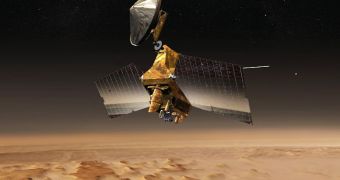NASA awarded the Distinguished Public Service Medal to scientist Scott Murchie, in a ceremony that took place on June 30 at the agency's Headquarters, in Washington, DC. Administrator Charles Bolden presented the prestigious award, the highest NASA can give to a non-government collaborator.
Murchie is based at the Johns Hopkins University (JHU) Applied Physics Laboratory (APL), in Laurel, Maryland. He received the prize for his work as principal investigator of the Compact Reconnaissance Imaging Spectrometer for Mars (CRISM) instrument.
CRISM is installed aboard the NASA Mars Reconnaissance Orbiter (MRO), which has been orbiting the Red Planet since March 10, 2006. The spacecraft is one of the American space agency's finest, having already sent back massive volumes of data.
Both the CRISM instrument and science teams received the NASA Public Service Group Achievement Award for their accomplishments in managing this successful mission. These team members join a very select group of scientists that received such awards.
The reason why this spectrometer is so important is that it brings an amazingly-important contribution to studies seeking to determine whether liquid water ever flowed on the surface of Mars. It can detect phyllosilicates (or clays) on the Red Planet's surface.
This is important because these materials only form in the presence of liquid water. MRO's instruments played a very important role in confirming that the liquid existed on the surface of Mars as recent as 1 billion years ago.
“I'm incredibly flattered by this honor from NASA, which is really an acknowledgement of the fine team of people I work with on CRISM, as well as on MESSENGER and, a decade ago, on NEAR. APL has a great team mentality, and it's an honor to be part of that,” Murchie explained.
The first head of the APL Space Department, assistant director Richard B. Kershner, is the only other APL expert ever to receive the prestigious award. Murchie's role in developing a camera for the MESSENGER spacecraft was also taken into account.
MErcury Surface, Space ENvironment, GEochemistry and Ranging (MESSENGER) is a space probe developed by NASA, which became the first orbiter around Mercury. It achieved orbital insertion around our solar system's innermost planet on March 18, 2011, SpaceRef reports.

 14 DAY TRIAL //
14 DAY TRIAL //